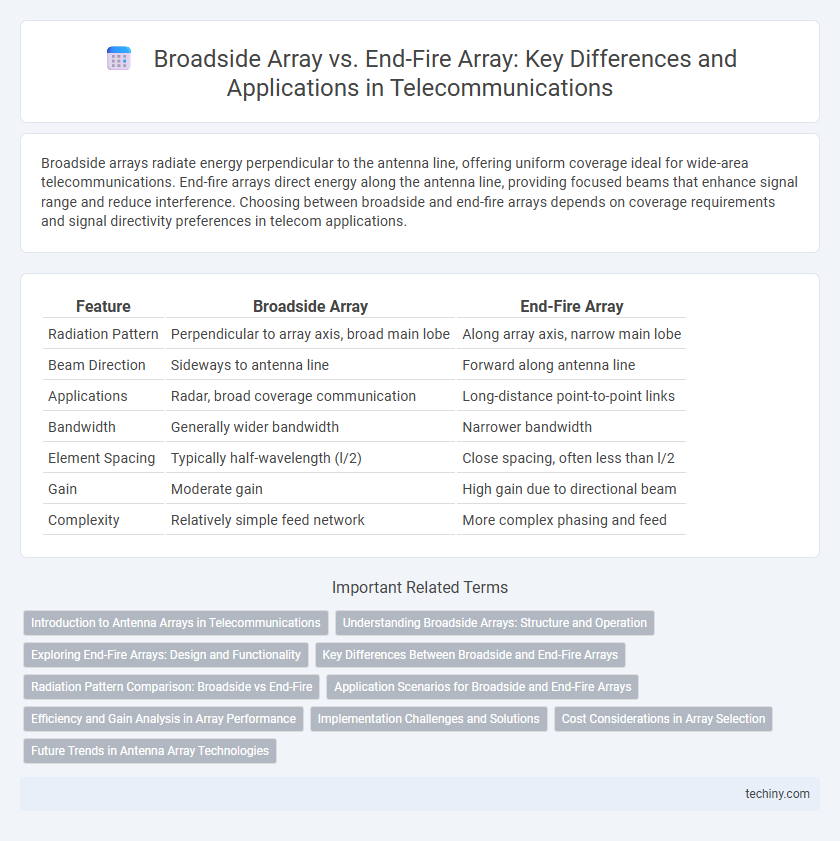Broadside arrays radiate energy perpendicular to the antenna line, offering uniform coverage ideal for wide-area telecommunications. End-fire arrays direct energy along the antenna line, providing focused beams that enhance signal range and reduce interference. Choosing between broadside and end-fire arrays depends on coverage requirements and signal directivity preferences in telecom applications.
Table of Comparison
| Feature | Broadside Array | End-Fire Array |
|---|---|---|
| Radiation Pattern | Perpendicular to array axis, broad main lobe | Along array axis, narrow main lobe |
| Beam Direction | Sideways to antenna line | Forward along antenna line |
| Applications | Radar, broad coverage communication | Long-distance point-to-point links |
| Bandwidth | Generally wider bandwidth | Narrower bandwidth |
| Element Spacing | Typically half-wavelength (l/2) | Close spacing, often less than l/2 |
| Gain | Moderate gain | High gain due to directional beam |
| Complexity | Relatively simple feed network | More complex phasing and feed |
Introduction to Antenna Arrays in Telecommunications
A broadside array in telecommunications features antenna elements arranged to radiate perpendicular to the array line, delivering a high-gain, wide-angle coverage suitable for broadcast applications. In contrast, an end-fire array directs energy along the axis of the array, providing focused, narrow-beam communication ideal for point-to-point links. Understanding the radiation patterns and directivity of each array type is crucial for optimizing antenna performance in wireless networks and satellite communication systems.
Understanding Broadside Arrays: Structure and Operation
Broadside arrays consist of multiple antenna elements arranged linearly with equal spacing and fed in phase to produce a radiation pattern perpendicular to the array axis, maximizing directivity broadside to the array line. The uniform excitation of elements leads to constructive interference in the broadside direction, creating a main lobe with decreased side lobes for enhanced signal strength and reduced interference. These arrays are widely used in telecommunications for applications requiring high gain and precise beam steering, such as radar and wireless communication systems.
Exploring End-Fire Arrays: Design and Functionality
End-fire arrays achieve directional signal transmission by aligning multiple antenna elements in a linear configuration, radiating energy primarily along the axis of the array. Their design utilizes phase shifts between elements to reinforce signals in the end-fire direction, enhancing gain and directivity compared to broadside arrays, which radiate perpendicular to the element axis. This functionality makes end-fire arrays ideal for applications requiring focused long-distance communication and interference reduction in telecommunications.
Key Differences Between Broadside and End-Fire Arrays
Broadside arrays radiate energy perpendicular to the antenna line, providing a wider coverage area with uniform signal strength, making them ideal for broad-area communication. End-fire arrays direct energy along the axis of the antenna line, resulting in a narrower beamwidth and greater directivity, useful for point-to-point communication. Key differences include the radiation pattern orientation, beamwidth, and use cases, with broadside arrays offering wider coverage and end-fire arrays providing enhanced gain and reduced interference in specific directions.
Radiation Pattern Comparison: Broadside vs End-Fire
Broadside arrays generate a radiation pattern with maximum gain perpendicular to the array axis, offering a wide beamwidth ideal for broad coverage and uniform signal strength over large areas. End-fire arrays focus their radiation along the axis of the array with a narrower beamwidth, achieving higher directivity and gain in a specific direction, which suits point-to-point communication links. The choice between broadside and end-fire arrays depends on the application's need for either wide-area coverage or focused directional transmission in telecommunications.
Application Scenarios for Broadside and End-Fire Arrays
Broadside arrays are ideal for applications requiring wide azimuth coverage, such as radar systems and broadcast communication, where signals need to be transmitted or received perpendicular to the antenna axis. End-fire arrays are preferred in point-to-point communication and directional radar systems, focusing energy along the array axis for long-range, high-gain performance. These distinct radiation patterns allow broadside arrays to excel in area coverage, while end-fire arrays optimize narrow beam steering and target tracking.
Efficiency and Gain Analysis in Array Performance
Broadside arrays exhibit higher radiation efficiency due to uniform current distribution across elements, resulting in improved gain when radiated perpendicular to the array axis. End-fire arrays achieve maximum gain along the array axis by constructive interference of phase-shifted signals, optimizing directivity but often at the cost of reduced efficiency due to increased mutual coupling. Analyzing array performance highlights that broadside arrays suit applications requiring stable gain and efficient power use, while end-fire arrays excel in directional gain despite potential efficiency trade-offs.
Implementation Challenges and Solutions
Broadside arrays face implementation challenges such as precise element spacing to avoid grating lobes, requiring uniform phase control and robust feed networks that can increase system complexity and cost. End-fire arrays demand careful impedance matching and phase shifting to achieve constructive interference along the boresight, with solutions involving advanced beamforming algorithms and adaptive calibration techniques to maintain performance in dynamic environments. Both array types benefit from the integration of digital signal processing that compensates for hardware imperfections and enables flexible beam steering.
Cost Considerations in Array Selection
Broadside array antennas typically incur higher manufacturing and installation costs due to their larger physical footprint and complex mounting requirements compared to end-fire arrays. End-fire arrays offer cost efficiency by minimizing space usage and simplifying cabling, which reduces maintenance expenses in telecommunications infrastructure. Selecting an array configuration involves balancing initial expenditure against long-term operational costs, influenced by factors such as beam steering complexity and deployment environment.
Future Trends in Antenna Array Technologies
Broadside arrays provide stable, wide-angle coverage ideal for urban 5G networks, while end-fire arrays offer high directivity suitable for point-to-point millimeter-wave links. Future trends emphasize hybrid configurations integrating AI-driven beamforming for dynamic spectrum management and improved signal-to-noise ratios. Innovations in metamaterials and reconfigurable antennas promise enhanced bandwidth efficiency and reduced interference for next-generation wireless systems.
Broadside Array vs End-Fire Array Infographic

 techiny.com
techiny.com